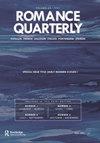中世纪西班牙传说与史诗文本中的强奸、性、暴力与耻辱
IF 0.2
3区 文学
0 LITERATURE, ROMANCE
引用次数: 0
摘要
本文确定并探讨了性和暴力在几个中世纪西班牙文本中表现的两种方式。在分析的第一组故事中,强奸和与性有关的暴力被谴责为背信弃义的侮辱,导致女性受害者和她周围的男性形象——即她的父亲或未婚夫——蒙羞。然而,这些情节揭示了关键女性角色的令人钦佩的品质,并经常为男性主角的英雄形象做出贡献。在第二组中,受害者的角色仅限于忍受性侮辱——纳妾或强奸——并生下私生子,以恢复失去的秩序。叙述者将这些贵妇的堕落视为英雄气概的表现,他们要么为她的家庭的耻辱而高兴,要么完全无视荣誉问题。所有被质疑的情节,其中一些本质上是暴力的,为叙事增添了一层戏剧性,也许在人性层面上引起了观众的共鸣。考虑到故事中的细节和记录在案的性暴力案件之间的一些相似之处,我们可能会想象,女性角色激励了那些由阅读或倾听公众组成的女性,在她们生活的危险的男性主导的世界中表现出同样的勇敢和坚韧。本文章由计算机程序翻译,如有差异,请以英文原文为准。
Rape, Sex, Violence, and Disgrace in the Legends and Epic Texts of Medieval Spain
Abstract This article identifies and explores two ways in which sex and violence are manifested in several medieval Spanish texts. In the first group of stories analyzed, rape and sexually-related violence are condemned as treacherous affronts that result in the dishonor of the female victim as well as a male figure in her orbit—namely, her father or her betrothed. Nevertheless, these episodes shed light on the admirable qualities of key female characters and often contribute to the heroic construct of the male protagonist. In the second group, the victims’ roles are limited to enduring a sexual indignity—concubinage or rape—and bearing the illegitimate child who will restore lost order. The narrators celebrate the degradation of these noblewomen as a manifestation of heroic prowess, and they either delight in her family’s disgrace or disregard the matter of honor entirely. All the episodes in question, some of which are violent in nature, add a layer of dramatism to the narration, and perhaps struck a chord with the audience on a human level. Considering some similarities between details in the stories and documented cases of sexual violence, we might imagine that the female characters inspired women who comprised a reading or listening public to act with equal bravery and resilience while navigating the dangerously male dominated world in which they lived.
求助全文
通过发布文献求助,成功后即可免费获取论文全文。
去求助
来源期刊

ROMANCE QUARTERLY
LITERATURE, ROMANCE-
CiteScore
0.30
自引率
50.00%
发文量
18
期刊介绍:
Lorca and Baudelaire, Chrétien de Troyes and Borges. The articles in Romance Quarterly provide insight into classic and contemporary works of literature originating in the Romance languages. The journal publishes historical and interpretative articles primarily on French and Spanish literature but also on Catalan, Italian, Portuguese, and Brazilian literature. RQ contains critical essays and book reviews, mostly in English but also in Romance languages, by scholars from universities all over the world. Romance Quarterly belongs in every department and library of Romance languages.
 求助内容:
求助内容: 应助结果提醒方式:
应助结果提醒方式:


